Dumbbell & Resistance Band Exercises For Seniors
Resistance and strength training are great ways for seniors to stay fit and active.
Cardio exercise and aerobics get most of the credit for keeping hearts healthy, but strength and resistance training can help seniors build muscle and make improvements throughout the whole body.
Both styles of exercise can work together to improve overall health in seniors.
That’s why we’ve put together this guide to strength and resistance training for older adults. Below you’ll discover how these workouts can improve your overall health and tips for incorporating dumbbell exercises and resistance training into your workout program.
The Top 6 Main Benefits of Dumbbell & Resistance Band Exercises For Older Adults
Dumbbell exercises and resistance workouts have a lot to offer older adults including each of the following benefits.
1. Stronger Lower and Upper Body
Your muscles become stronger as they experience tension. Working out with dumbbell weights and resistance bands puts your muscles under stress, allowing them to rebuild through and become stronger.
The various resistance band and dumbbell exercises for seniors we outline can give you a full-body workout, strengthening all your muscle groups.
2. Healthier Joints
The exercises we highlight below allow you to use and strengthen multiple joints in your body. It’s no secret that joints start wearing as we get older.
What senior do you know who doesn’t experience knee, shoulder, or elbow pain sometimes? These workouts will promote healthier joints, which will in turn reduce some of that pain.
3. Improved Balance and Stability
The more you use your body, the better. We’ve selected exercises that target muscles you rely on to keep your body centered and stable.
Frequent exercise is key if you want to have the strength to do daily tasks without fear of falling.
4. Maintain a Healthy Body Weight
You’ve probably heard the old adage “muscle weighs more than fat.” Well, it’s true.
The more you build muscle, the more you gain the right kind of weight and shed the bad kind, helping you maintain a healthy body weight in the long run.
5. Boost bone density
Your muscles aren’t the only things that become stronger with a good dumbbell workout and resistance training.
Your bones become stronger, too. This is big for seniors because it can reduce the risk of breaks.
6. No gym membership needed
The gym is not for everyone. Many people would rather stay at home and workout, and these exercises we highlight here can be done with or without a gym membership.
Most gyms are equipped with dumbbells and resistance bands, but you can also just buy them and do these exercises in the comfort of your home. It really just depends on what you like.
7 Easy Resistance Band Exercises For Seniors
Not all weight training is created equal, especially for older adults. It’s really important to find the right workouts that won’t cause any damage to your body.
Resistance exercises can be a powerful piece to an older adults’ exercise program because the bands give seniors a chance to more safely find how much they can push while reducing the chance of injuries.
Before we dive into the specific exercises, here are a few general tips that can apply to each one:
- Start slow and don’t strain yourself. Remember that exercise is supposed to be for long term health. Getting hurt isn’t part of that.
- Find a band with low resistance at the beginning. They come in different varieties, so pick one that feels good to you. You can always move on to harder ones as you progress.
- Always talk with your physician before kicking off a new exercise regimen. They can help you determine what’s right for your unique circumstances.
Once you’ve got those things squared away, you can start incorporating resistance training. Here are a few moves to consider.
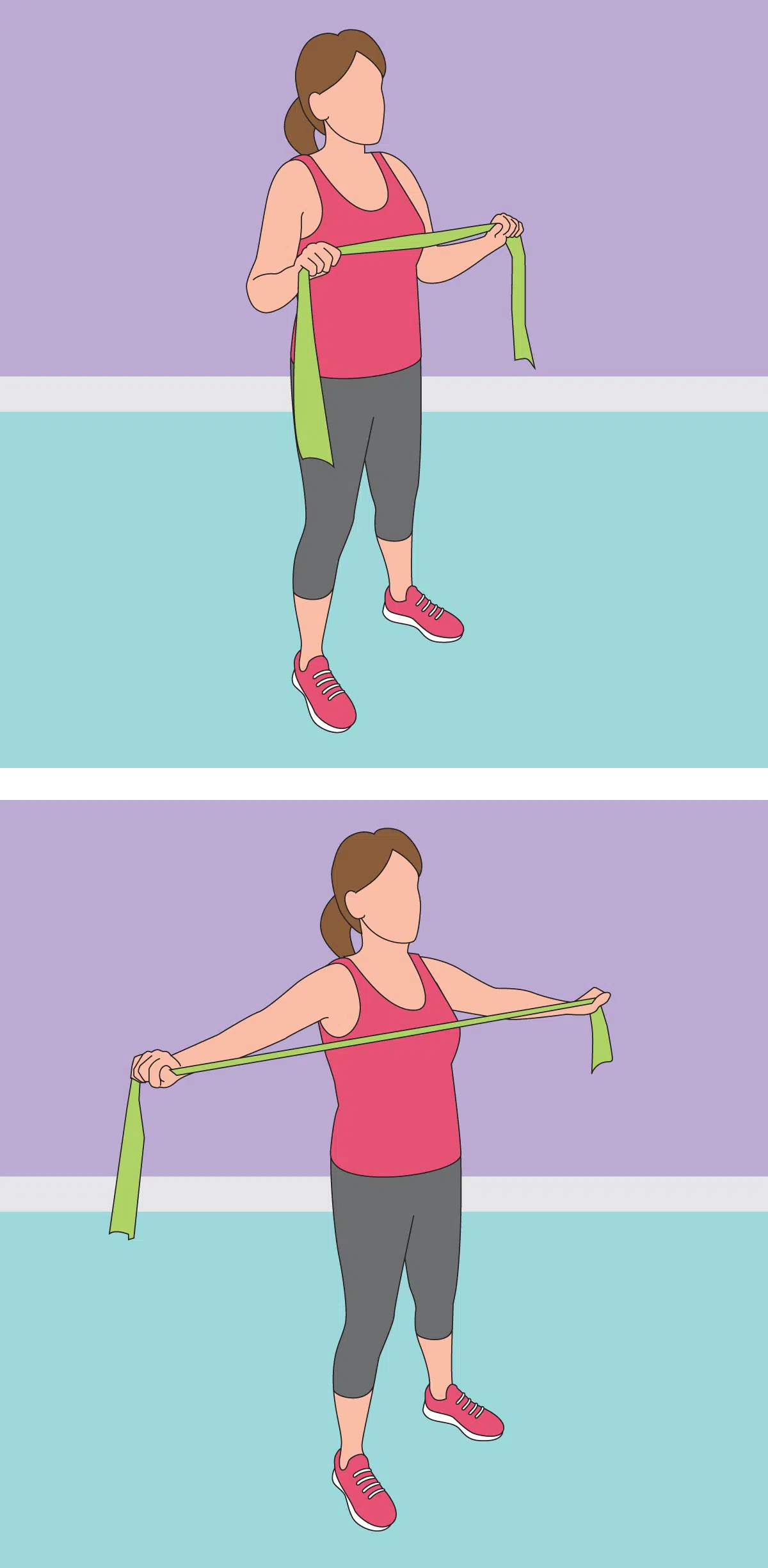
1. Chest Pull
The chest pull can be done in a chair or on your feet depending on what you prefer. Once you decide which one works for you, follow these simple steps to strengthen your upper body.
- Grab both ends of your resistance band and hold it in front of your chest with your elbows bent.
- Keep your back straight and your core engaged; then take a deep breath in.
- As you exhale, pull the band apart and closer to your chest. Straighten your arms the best you can.
- Inhale again as you release the tension and return to the starting point.
- Repeat for 10-15 reps.
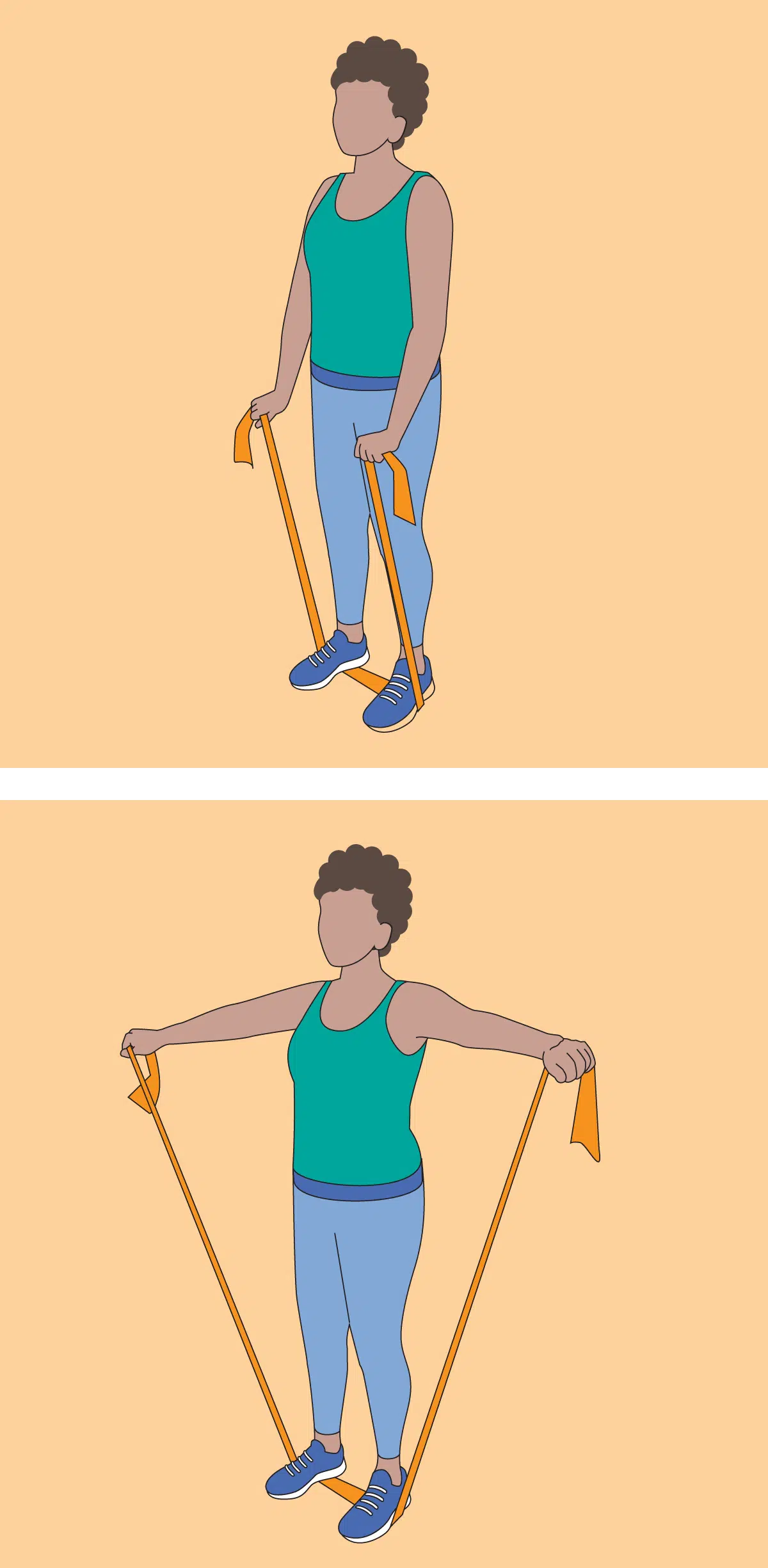
2. Lateral Raise
This exercise needs to be done standing up and will help you build the muscles around your shoulder blades.
- Stand shoulder-width apart in the middle of your resistance band.
- Grab both ends of your band with your palms facing down and your thumb knuckle points forward.
- Raise your arms to the side until they reach shoulder height.
- Return back to the starting position.
- Repeat for 10-15 reps.
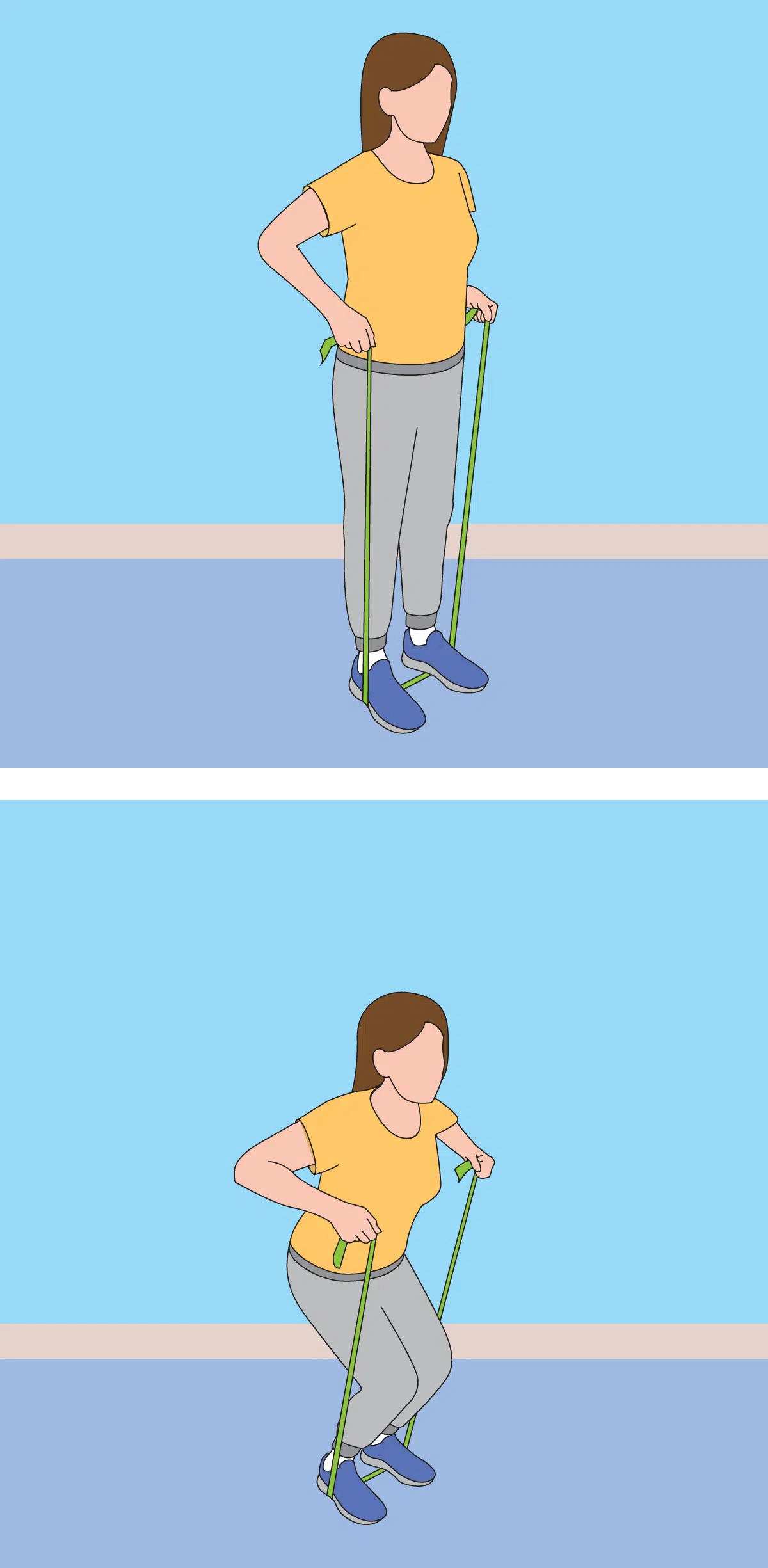
3. Squats
A squat is a compound exercise, meaning it works the upper and lower body.
This helps seniors build the muscle groups they use every day, so they can more easily do daily activities like getting up and down from a seated position.
In addition, squats also work your core muscles so you can improve your body’s overall stability and balance.
Here’s how to do it with your resistance band:
- Stand shoulder-width apart in the middle of your resistance band.
- Grab both ends of your band with your palms facing down and your thumb knuckle points forward.
- Pull the band towards the middle of your body so you feel its resistance.
- Bend your knees slowly so you end up in a squat position. Keep your back straight, your bottom out, and your knees behind your toes.
- Return to starting position.
- Repeat for 10-15 reps.
Here’s a key thing to remember: You don’t have to get all the way down to the ground to make this successful. Just get to a place where you feel secure and confident in your movements.
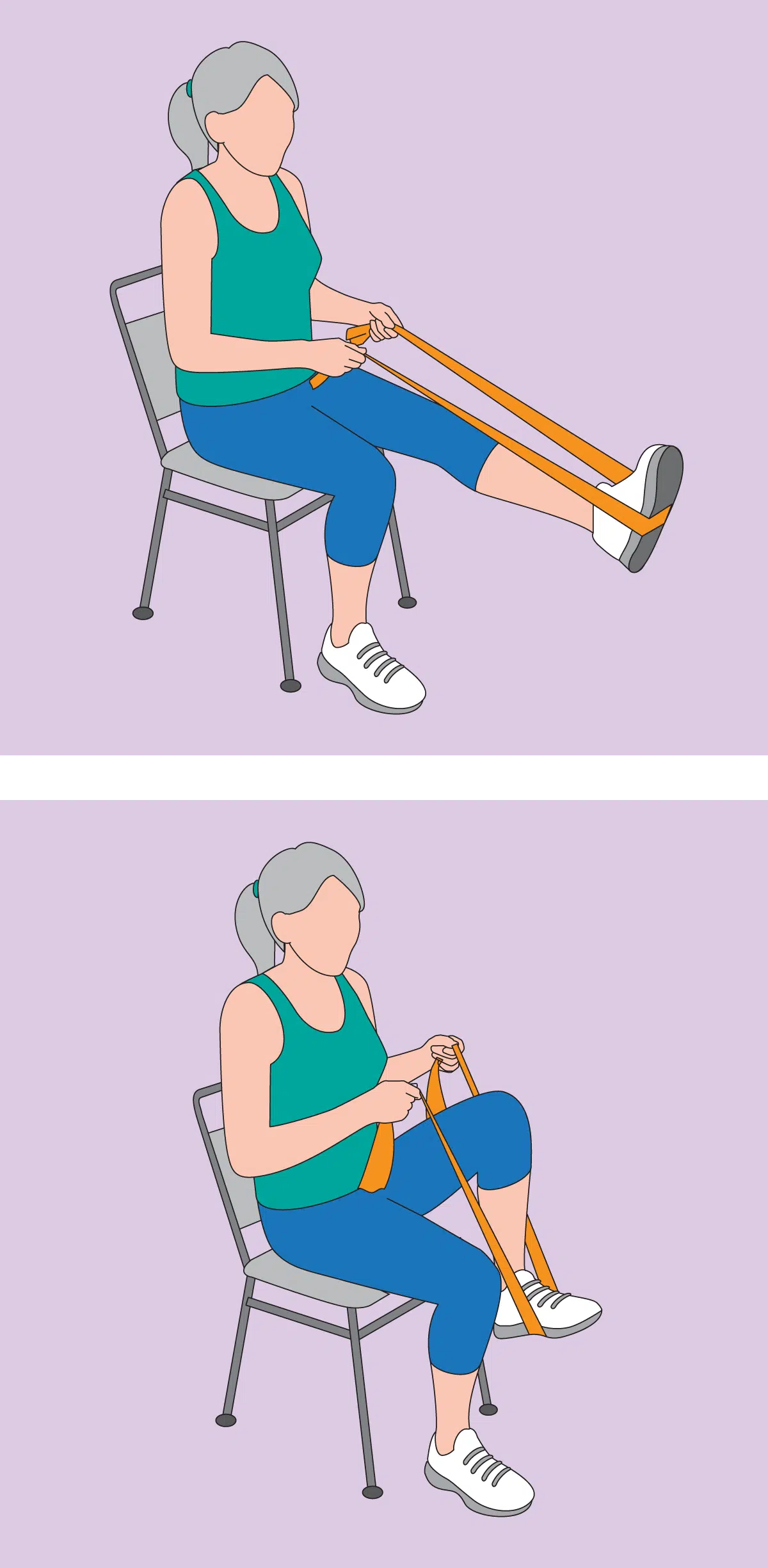
4. Leg Press
This resistance exercise works your lower body while also helping you stretch your leg muscles. You’ll need a nice, strong chair for this one.
- Sit in the chair with your back straight while holding both ends of the resistance band.
- Place your left foot in the middle of the band and then extend it out, keeping your right foot firmly on the ground.
- Bend your left knee up towards your chest.
- Straighten it back again.
- Bring your body back to the starting position.
- Alternate sides.
- Repeat for 10-15 reps on each leg.
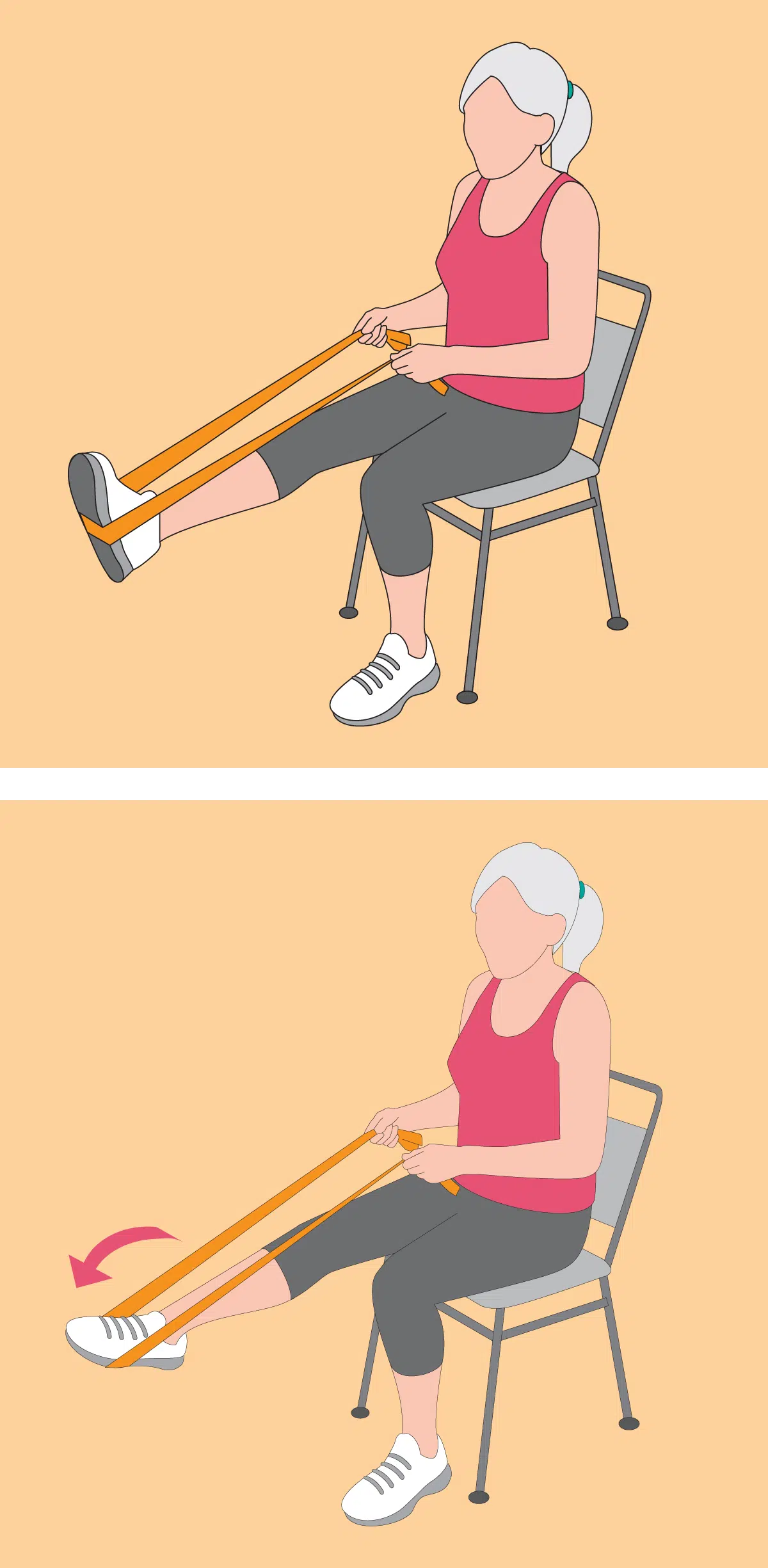
5. Calf Press
Another lower body exercise, the calf press strengthens your quads, glutes, hamstrings, hips, and (of course) calves. Here’s how you can see the benefits of this exercise.
- Sit in the chair with your back straight while holding both ends of the resistance band.
- Place your left foot in the middle of the band and extend it out.
- Once extended, point your toes up to the ceiling.
- Pull your toes back down so that they’re pointed at the floor.
- Repeat this back and forth process 10-15 times.
- Switch sides and repeat the process.
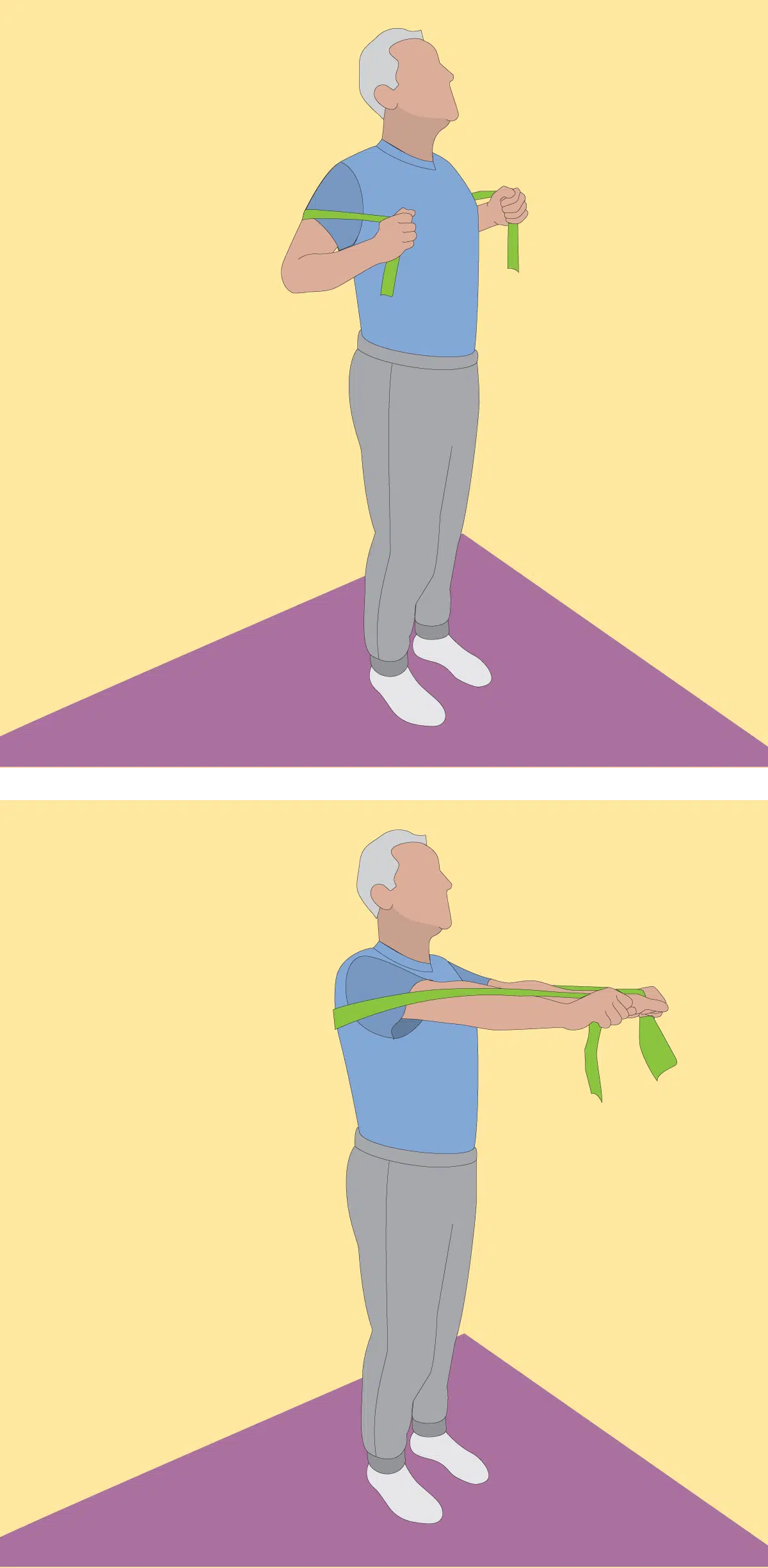
6. Chest Press
This workout is similar to a dumbbell chest press, but you don’t need a bench to do it with a resistance band. You can do it either sitting or standing.
- Hold both ends of your resistance band and put the middle part behind your body, level with your shoulders.
- Extend your arms so your hands end up in front of your chest.
- Return to the starting position.
- Repeat for 10-15 reps.
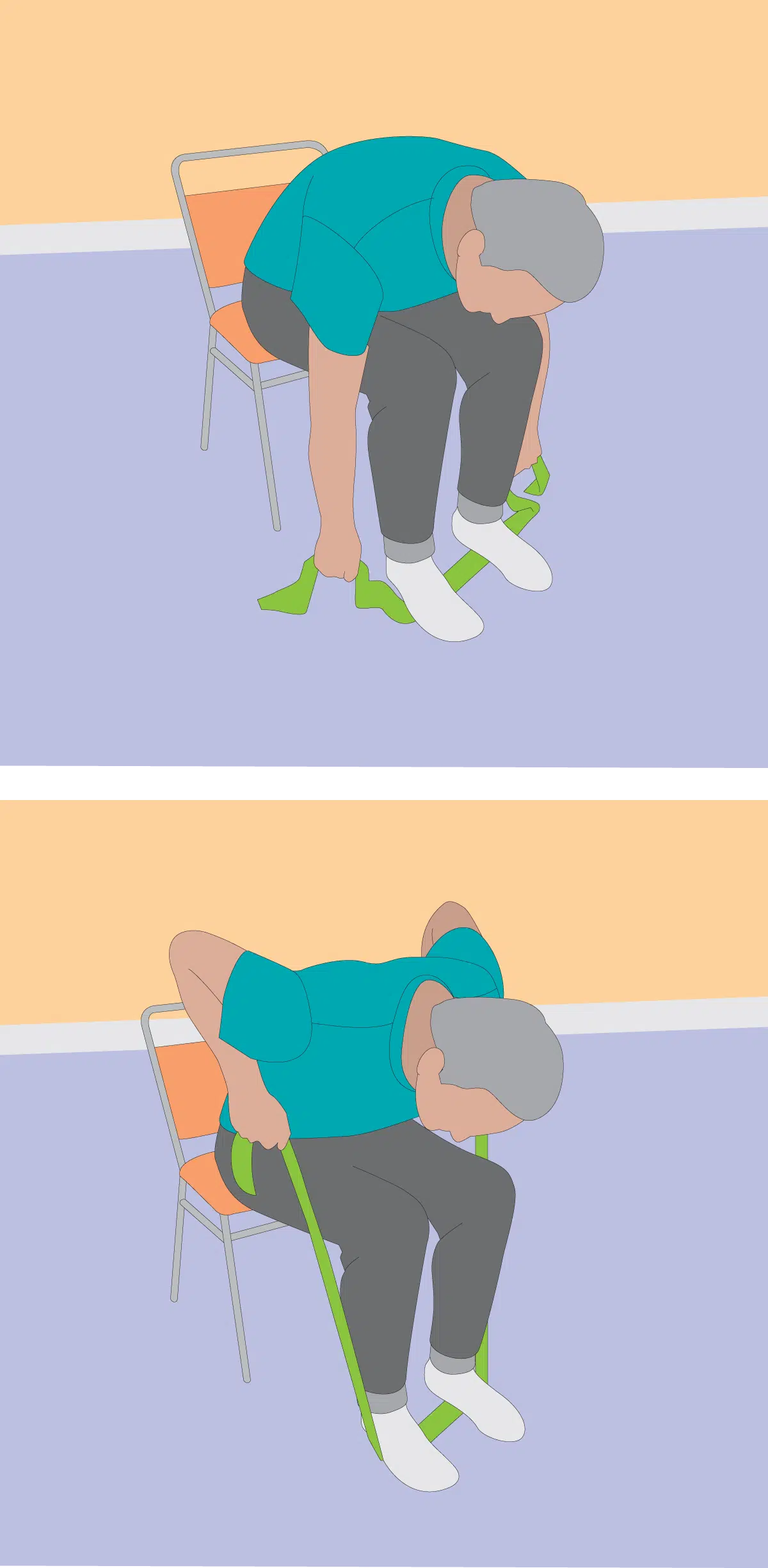
7. Bent Over Row
The bent over row is another seated resistance exercise. There are also a few variations that can boost intensity as you get used to the movements. Here’s the basic way to start:
- Sit on your chair while stepping on your band and gripping both handles.
- Engage your core then bend your upper body forward until your parallel with the floor.
- Make sure your hands are pointed towards the ground and your palms facing backward.
- Bring your arms to the ground.
- Pull your hands up toward your chest, allowing your shoulder blades to get closer. Your elbows will be pointed up to the ceiling.
- Bring your body slowly back to the starting point.
Repeat for 10-15 reps.
To modify the intensity, you can increasingly move your feet further apart. Or, you can move them closer together if it feels too rough.
7 Best Dumbbell Exercises For Seniors
Dumbbell exercises work some of the same muscles as resistance bands, but they are a bit more advanced and have a higher risk of injury.
Accidents can happen from dropping the weights and bad form can lead to muscle tears and other damage. That’s why it’s super important to get the motions right.
Here are a few ideas to help you minimize your risks:
- Start with really light weights to help them get used to the movements.
- Try to do the motions without any weight at all in the beginning.
- Monitor your form.
- Work with a personal trainer or a spotter will also help identify areas where things aren’t going well.
- As always, check with your physician before you get started.
Once you feel confident that you won’t cause your body harm by using dumbbells, you can start practicing the following 7 dumbbell exercises for seniors.
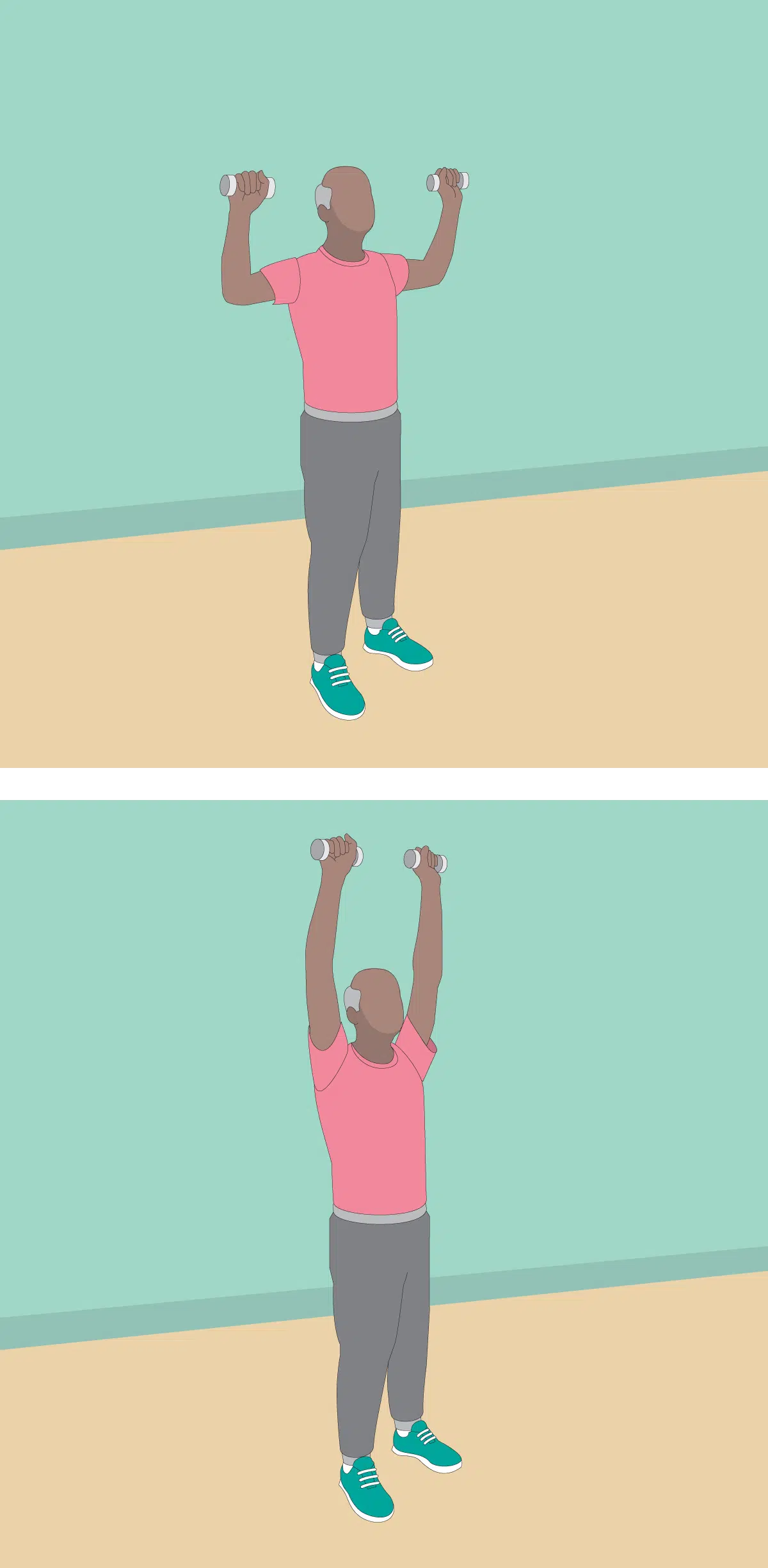
1. Overhead Press
The overhead press can be done in a seated or standing position. Standing is a bit harder, since it will engage more of your core muscles, and sitting will allow you to support your back muscles as you workout.
Once you decide how you will start, the rest of the steps are the same.
- Keep your body straight
- Grip the dumbbells like you’re gripping handlebars: knuckles up and thumbs on the inside of the dumbbell. This is called an “overhand grip.”
- Hold the dumbbells at the height of your shoulders.
- While controlling your breath, raise your arms over your shoulders and above your head.
- Hold this position for one second.
- Bring your arms back to the starting position.
Knowing how many reps to do will depend on your strength starting out, but you can set a reasonable goal of three sets of 8-12 reps.
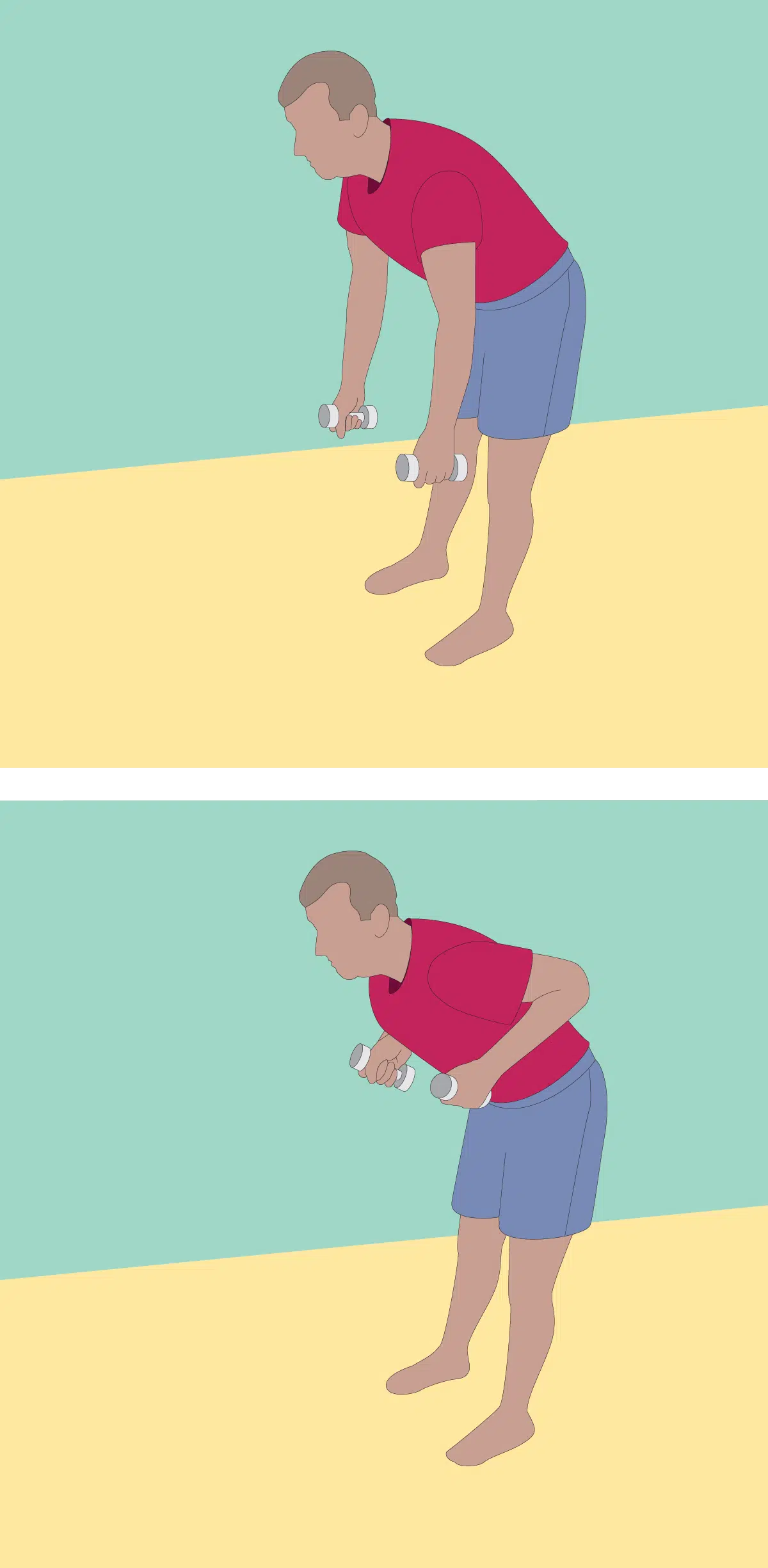
2. Bent Over Rows
The dumbbell bent over row, also called the dumbbell row, is a great way for seniors to work their shoulder and back muscles. Follow these steps to do this exercise:
- Stand up, keeping your knees slightly bent, your feet shoulder-width apart, and your palms facing one another, holding a dumbbell in each one.
- Bend over at the waist 45 degrees with your back kept straight.
- Inhale deeply.
- As you exhale, pull the dumbbells up towards your chest. Don’t go higher than your shoulders and keep your wrists and legs stable as you raise the weights.
- Take another breath in and slowly bring the dumbbells back down to the starting position.
- Repeat the exercise 8-12 times in a set and aim for three sets throughout your workout routine.
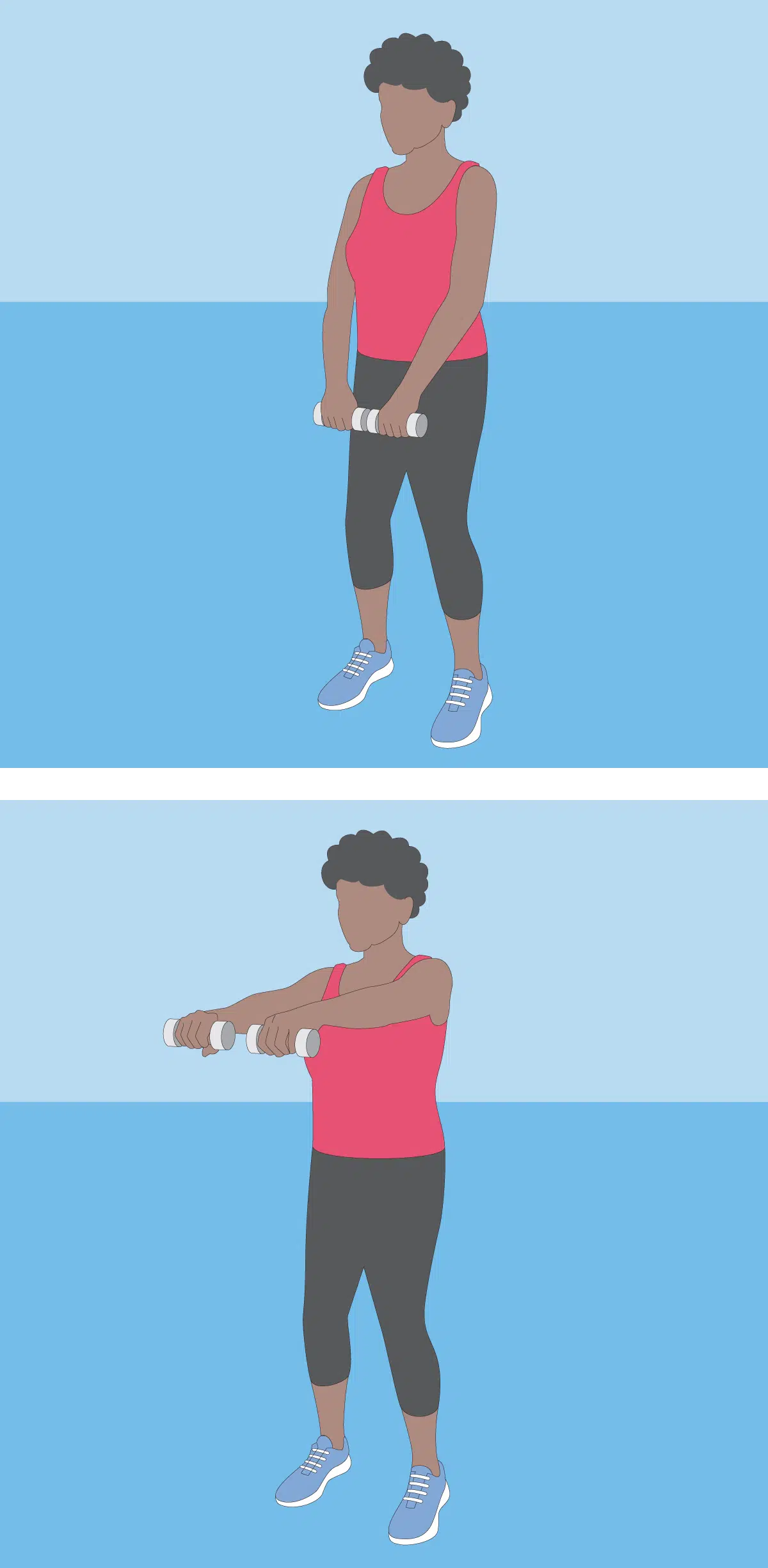
3. Front Raise
The Front Raise is a classic dumbbell workout that’s great for people just getting started with strength training.
- Get started by standing with weights in your hands and your knees slightly bent. Keep your feet flat and shoulder-width apart.
- Hold your weights between your legs with an overhand grip. Keep your palms facing your body.
- Inhale and engage your core muscles as you raise your arms straight up with a gentle bend at the elbow.
- Pause once your arms are in a straight line, even with your shoulders.
- Exhale and bring the weights back to the starting position.
8-12 reps in three sets is a great place to start with this workout as well. Your weights could range between 5-10 pounds if you’ve never done this before, and then you can work your way up as you go.
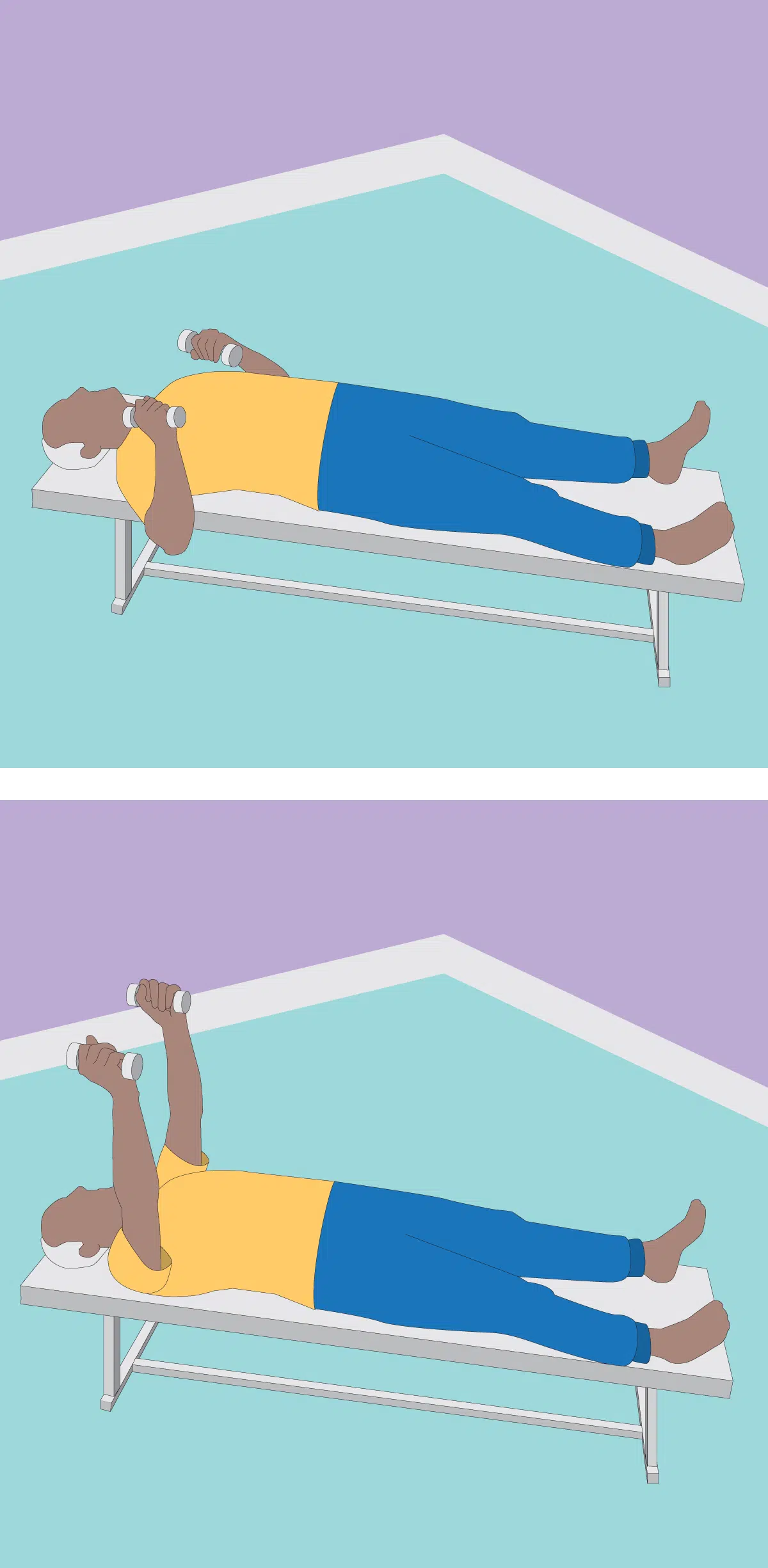
4. Chest Press
The dumbbell chest press involves lifting your dumbbells up over your torso while lying on your back. Traditionally it’s done on a workout bench, but it can also be done on the floor or with a Swiss ball if you have one.
No matter what, this dumbbell workout will help strengthen major muscle groups in your upper body. Here’s how it’s done:
- Lie down on your back, holding your dumbbells horizontally with your knuckles back towards your head. Your elbows should be out and aligned with your shoulders and your arms straight.
- Extend your arms out above your chest.
- Bring your arms back down to the starting position.
Remember to keep good form with this move (and the others). Failing to do so can result in injury, so make sure you don’t let your elbows drop below your shoulders if you’re using a bench. Aim for 8-12 reps and three sets.
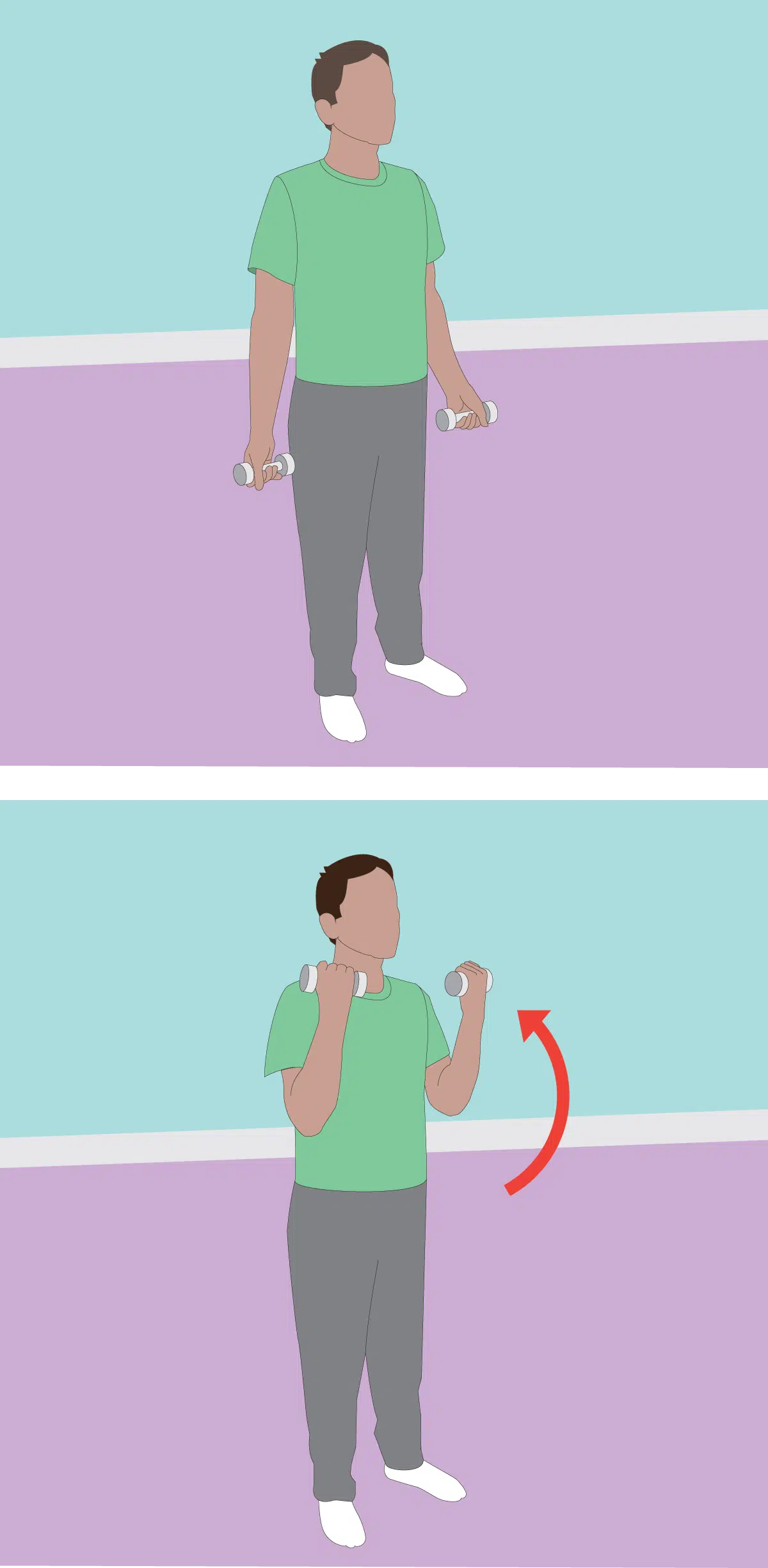
5. Bicep Curls
Bicep curls are a staple of dumbbell workouts and it’s one of the top dumbbell exercises you can do. When you picture somebody using dumbbells, this is probably the exercise you see. Here’s how you do it with good form:
- With flat feet, stand upright with your legs shoulder-width apart.
- Hold one dumbbell in each hand, allowing your arms to fall to your side naturally. Have your palms facing outward.
- Bend your elbows, raising the weight up to your chest. Your arms should remain stable and your shoulders relaxed.
- Slowly bring the weights back down to the starting position.
- Repeat 8-12 times in three sets.
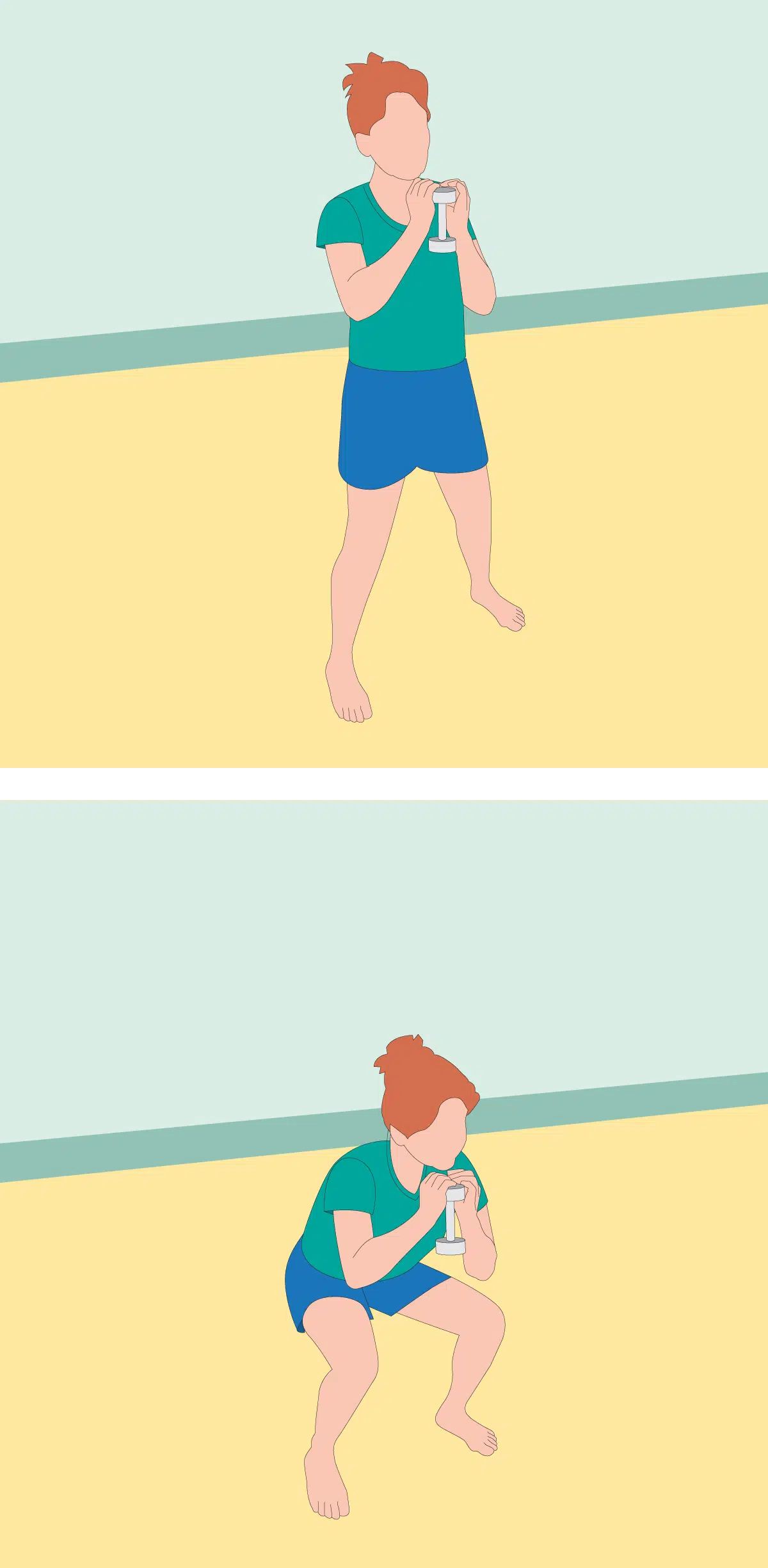
6. Dumbbell Squat
The dumbbell squat is a compound exercise, meaning they work the upper and lower body. This helps seniors build the muscle groups they use every day, so they can more easily do daily activities like getting up and down from a seated position.
In addition, the dumbbell squat also works your core muscles so you can improve your body’s overall stability and balance.
Here’s how it’s done:
- Hold the end of one dumbbell with both hands in the center of your chest.
- Spread your legs out wider than your hips. Keep your feet flat and your toes either facing forward or slightly turned out.
- Tighten up your core and then tend your knees and hips so you sink into a squatting position.
- Stop when your legs are parallel with the floor. (As you start out, you may not make it that far. That’s fine. Just go as low as you can while maintaining good form.)
- Move your body back to the upright position.
Since squats use your whole body, you might find that you can use more weight than you can do other exercises. Make sure you don’t push yourself too hard, though, as you don’t want to risk an injury, and remember that you don’t need to go all the way down to the ground. Like with the resistance bands, you should find a position that still allows you to feel secure and confident.
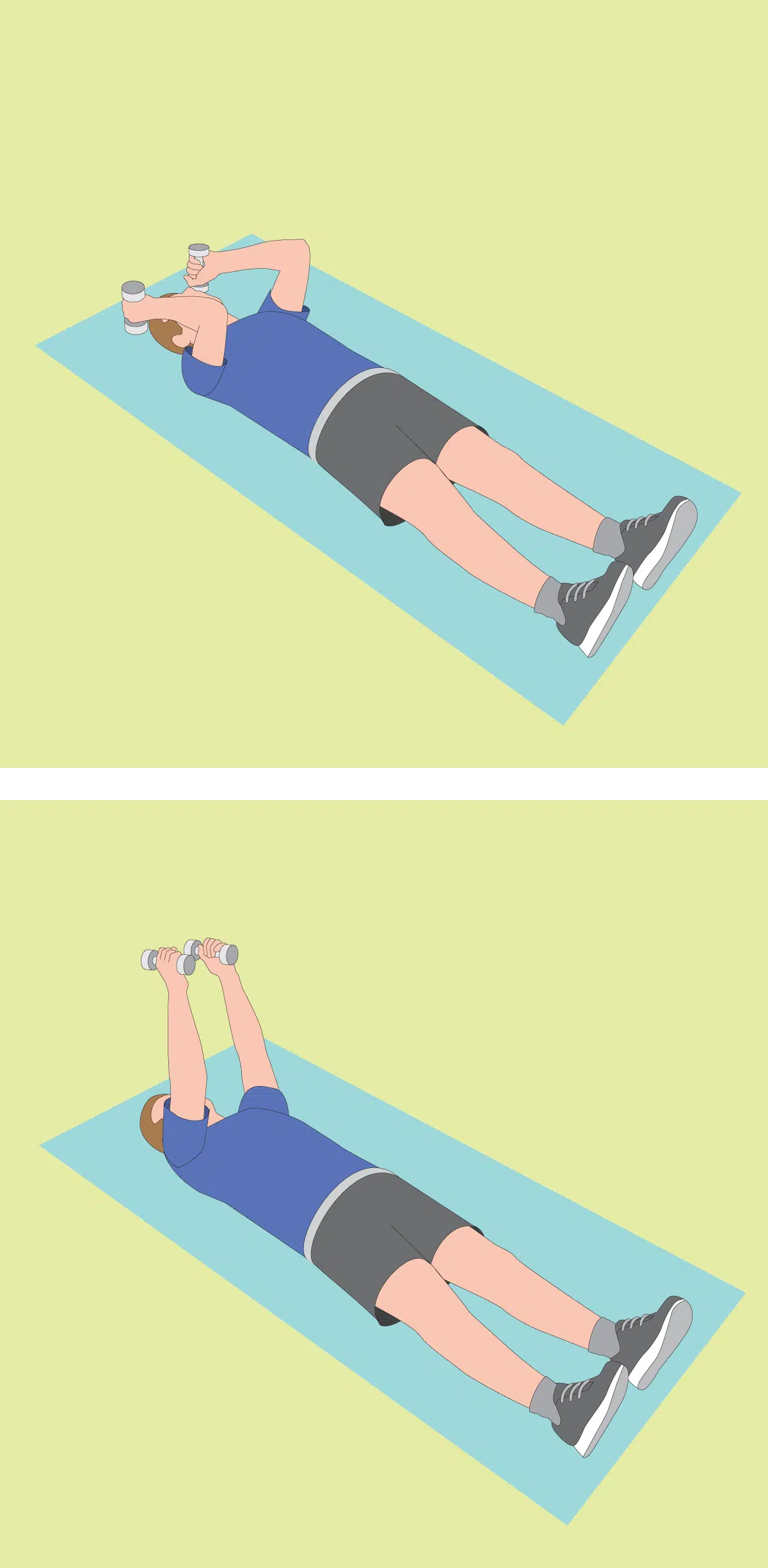
7. Lying Triceps Extension
This is a triceps isolation exercise that targets the lower parts of your arm. Like the chest press, this exercise works best with a bench.
- Lie on a bench with a dumbbell in each of your hands extended out and above your chest.
- Bend your elbows so the weights move down above your shoulders.
- Keep your upper arms stable.
- Pause at the bottom for a moment.
- Bring the weights back up to the starting position.
- Repeat with 8-12 reps and 2 sets as you begin.
How Exercises Help Seniors Avoid Falls
Having a regular exercise program can go a long way in helping seniors avoid falls. As your body gets stronger, you also improve your flexibility, balance, and mobility.
Mixing dumbbell exercises or resistance training into your workout routine will help give your body what it needs to stay upright.
Remember to always keep proper form, rest when needed, and stop exercising if you feel your body can’t handle it. Talk with your physician about what exercises are right for you, especially if you have a medical condition. None of what we’ve written here should be taken as professional medical advice. You will still want to clear everything with an expert.
Once you do receive the okay, you’re ready to buy some dumbbells and a resistance band so you can start experiencing the benefits of these exercises.
